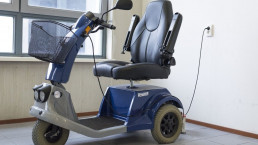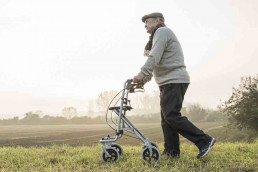Power Chair Safety: Tips for Use in a Skilled Nursing Facility, at Home, and in the Community
A manual wheelchair could be assigned to just about anyone because it offers stationery use as well as voluntary self-propulsion at calm speeds.
When a motor is added, upgrading the seated contraption into a power chair, red flags should be popping up indicating serious safety precautions.
The user now has access to immediate self-propulsion with a jerk of the joystick, granting them high speeds for indoor and outdoor use.
If user receives appropriate training, then using the power chair provides enhanced and safe mobility around their home and their community.
However, if a power chair is handed to anyone with limited to zero training and with no consideration for physical/cognitive capabilities, the end result could be disastrous for the user and those in their surrounding environment.
The following are a few tips to promote safe use of a power chair in three settings: a skilled nursing facility, a private home, and in the community.
Consult with primary physician and specialists: Before you get “Click to Order” button-happy, consider the benefits of consulting with a specialist and undergoing an evaluation first.
Like a car, you would not allow a person with severe dementia or with bilateral glaucoma drive a motorized chair. If potential users, family members, or caregivers have concerns regarding vision, cognition, or any deficit that could lead to injury to the user or to others while operating the chair, make the wise decision to seek out a safety evaluation.
Participate in power chair use training: For patients who reside in a skilled nursing or long-term care setting, medical staff may be bound by specific policies regarding power chair evaluations and use.
For example, residents who receive a doctor’s order to be fitted for a power chair will have to undergo several steps including: a consultation with a wheelchair specialist and a rehabilitation therapist (usually occupational or physical therapy), training in a demo chair conducted by the therapist, and evaluations to obtain insurance coverage for the chair.
For persons who are buying the chair for private residential use, it is recommended to consult with a medical equipment specialist about correctly operating the chair for indoor and outdoor use.
Opt for a demo or a rental: If you live at home and/or you are worried about whether or not you can safely use a power chair in your living space, contact a medical equipment company about renting or borrowing a demo chair.
Rentals means delaying financial commitment to your own chair while providing you time to select a chair that fits your body type, fits in your home, and fits your daily needs for mobility at home and in the community.
Read the Instructions: Specifically, brush up on the user manual for the chair’s intended purposes. Too often, users attempt to propel power chairs over rough and unpredictable terrain when the chair was never designed for outdoor use.
If you need a chair for both indoor and outdoor use, thoroughly research power chairs that can meet your criteria to minimize damage to the chair and to yourself.
Prepare for the worst scenario: When going on a community outing with a power chair, be prepared for the worst circumstances: medical emergencies and chair stalling.
Wear weather-appropriate clothing to reduce exposure injuries. Bring plenty of water, snacks, and back-up medication. Have the chair battery fully charged before departing and bring the charger with you.
Pack a fully charged cellphone and the charger for complete emergency access. Always tell someone where you are going and when you plan on returning home.
Bring a chaperone with you: If you are new to using a power chair, don’t be shy and ask someone to supervise you. It could be for a simple jaunt around the facility, reversing out of a tight space, or taking a community outing.
Make sure that the chaperone fully understands that if the chair stalls or tips that it is not their responsibility to push or catch the chair. In order to avoid injury and to have complete access to emergency personnel, the chaperone is responsible for making the 9-1-1 call or recruiting others for assistance.
Avoid Coronavirus Scams
Source: https://www.consumer.ftc.gov/features/coronavirus-scams-what-ftc-doing
Scammers are taking advantage of fears surrounding the Coronavirus.
Here are some tips to help you keep the scammers at bay:
Hang up on robocalls. Don’t press any numbers. Scammers are using illegal robocalls to pitch everything from scam Coronavirus treatments to work-at-home schemes. The recording might say that pressing a number will let you speak to a live operator or remove you from their call list, but it might lead to more robocalls, instead.
Ignore online offers for vaccinations and home test kits. Scammers are trying to get you to buy products that aren’t proven to treat or prevent the Coronavirus disease 2019 (COVID-19) — online or in stores. At this time, there also are no FDA-authorized home test kits for the Coronavirus.
Fact-check information. Scammers, and sometimes well-meaning people, share information that hasn’t been verified. Before you pass on any messages, contact trusted sources.
Know who you’re buying from. Online sellers may claim to have in-demand products, like cleaning, household, and health and medical supplies when, in fact, they don’t.
Don’t respond to texts and emails about checks from the government. The details are still being worked out. Anyone who tells you they can get you the money now is a scammer.
Don’t click on links from sources you don’t know. They could download viruses onto your computer or device.
Watch for emails claiming to be from the Centers for Disease Control and Prevention (CDC) or experts saying they have information about the virus. For the most up-to-date information about the Coronavirus, visit the Centers for Disease Control and Prevention (CDC) and the World Health Organization (WHO).
Do your homework when it comes to donations, whether through charities or crowdfunding sites. Don’t let anyone rush you into making a donation. If someone wants donations in cash, by gift card, or by wiring money, don’t do it.
What the FTC is Doing
The FTC and FDA have jointly issued warning letters to seven sellers of unapproved and misbranded products, claiming they can treat or prevent the Coronavirus. The companies’ products include teas, essential oils, and colloidal silver.
The FTC says the companies have no evidence to back up their claims — as required by law. The FDA says there are no approved vaccines, drugs or investigational products currently available to treat or prevent the virus.
Source: https://www.consumer.ftc.gov/features/coronavirus-scams-what-ftc-doing
Preventing Falls at Home for Older Adults Using Today’s Technology and Products
The healthiest person can still experience a fall by pure accident or due to poor choices.
That being said, for the elderly it is not a matter of “if” they fall….it’s “when” they fall.
Reduced vision, decreased cognition, unstable standing balance, and generalized weakness/fatigue are just a few of the many fall-related factors that older adults experience simply due to the aging process.
Thanks to available medical technology and equipment, ground-level falls at home can be minimized.
Here are a few suggestions:
1. Cane - For mild standing balance weakness, a single-point cane or a quad cane could provide enough external support to prevent loss of balance.
Some older adults may handle indoor surfaces well enough without a cane, but reserve the option for outdoor use in order to scale rougher surfaces.
Persons who are thinking about incorporating a cane need to be able to weight-bear comfortably through both feet and have complete functional use of at least one arm.
2. Walkers/Rollators - If a cane is not good enough and the user is still experiencing a loss of balance, it may be time to upgrade to a walker.
For standard walker use, the older adults needs two functioning arms and needs to be able to comfortably weight-bear through at least one foot.
A walker provides more support for people who struggle standing up straight while walking. For individuals who fatigue easily, rollators come with a seat for periodic rest breaks.
3. Grab Bars - Installing grab bars is a great method for preventing an older adult from stabilizing on shaky objects like towel racks, oven doors, door knobs, top-heavy furniture, and wheeled chairs.
Grab bars could be placed just about anywhere in the house, but priority rooms should include the bathroom, the kitchen, and the bedroom.
Older adults conduct a lot of movement and transfers in all three rooms (getting out of bed, sitting on the toilet, climbing into the shower, getting dressed, etc.) over slippery surfaces, thus cultivating some major fall zones in the house.
4. Non-Slip Mats - Floor mats that provide some friction in connection to the floor and the bottom of the feet are helpful when placed on slippery bathroom floors and tiled/wooden floored living rooms and kitchen areas.
The mats need to be thin and well-adhered to the floor in order to prevent tripping or catching on the feet.
5. Seat Risers - Risers on the toilet or on dinner chairs help prevent “partial” falls. If the older adult has leg weakness (specifically in the quadriceps and hamstrings), a successful sit-to-stand transfer can turn into a lowering move to the floor.
A riser provides compensation for weakness, meaning that the individual doesn’t have to recruit as much muscle power to stand or sit.
6. Non-Slip Socks - Hospitals regularly hand out non-slip socks to fall-risk patients, but older adults are welcome to purchase the same socks for home use.
The bottom of the sock is lined with a rubber, friction-friendly material that prevents the wearer from slipping on smooth surfaces like tile, wood, linoleum, and cellar cement.
7. Bed Rails - Bed rails serve a similar purpose as seat risers in that, if properly used, assist a person getting in and out of bed by reducing muscle power to stand up or sit down.
An incomplete transfer could mean sliding off of the bed and onto the floor. Low-priced high quality bed rails can be located just about anywhere online, and the installation features are a frugal option over getting an expensive hospital bed.
8. Stair-Lifts - It’s a common fall prevention technique to avoid the stairways in a house. Unfortunately, some older adults don’t have that option in split-level homes, residences with steps up to the entryway, or houses where stairs must be scaled to get to the essential rooms (kitchen and bathroom).
Installation and parts can be expensive, but placing a stair-lift in the house could completely eliminate dangerous tumbles on stairways all-together.
9. Threshold Covers - Small door or room thresholds could be a huge tripping hazard for older adults who struggle with lifting their feet high enough to clear low-flying obstacles. Threshold covers or wedges can minimize the height.


